Vampires, whips, and gothic horror are together in full 3D for the first time in a while in Castlevania: Lament of Innocence, arguably the first polygonal Castlevania that's deserving of the name. Konami's ageless series of action games, which has enjoyed something of a renaissance these past few years on the Game Boy Advance, makes its inevitable debut on the PlayStation 2 with considerable aplomb. The game looks great, runs silky smooth, and features the best soundtrack heard in the series since the now-legendary 1997 title, Symphony of the Night. And, unlike the recent 2D Castlevania games, this one had to start from scratch and couldn't reuse a lot of the same graphics, sounds, and mechanics as its predecessor. This means that Lament of Innocence will offer an original experience to fans of the series, who'll undoubtedly enjoy seeing some of their favorite Castlevania monsters and gameplay rendered this well in 3D. On the other hand, this latest game in the series feels rather stripped down compared with, say, Castlevania: Aria of Sorrow, which was released earlier this year for the GBA. Lament is a fun, though fairly short and simple, game that marks a promising new beginning for this beloved series.

Every Castlevania game pretty much tells the same story: It's you, the lone adventurer, versus a deadly vampire, usually Dracula himself, and an evil castle filled with monsters that stand in the way. The particulars this time involve one Leon Belmont, who's every bit the dandy that the last few Castlevania heroes have been. He's a former aristocrat who's abandoned his title and courageously set forth in an attempt to rescue his beloved, who was apparently abducted by a vampire. Leon is just a short distance from the vampire's foreboding castle when he meets Rinaldo, a wise old alchemist who (in a surprisingly long-winded opening cutscene) gives to Leon a whip imbued with the power to thwart evil. Leon can't say no to that, and, whip in hand, he walks straight into his enemy's fortress. There, he'll face legions of skeletons, ghouls, demons, and more before he finally confronts his sworn enemy.
Any longtime Castlevania fan, when faced with the reality of a new 3D installment in the series, is concerned with just one question: Seriously, is it a Castlevania game? The straight answer, in this case, is yes--for the most part.
On the plus side, even if this game were called something other than "Castlevania," fans of the series would still, by all means, recognize it as such. It features many of the particular elements that fans of the series know and love, and while you might expect that it would be easy to brand just about any game featuring medieval weapons and undead monsters as a Castlevania, this one distinctly captures much of the look and feel that the best games in the series share in common. But, on the downside, Lament of Innocence simply lacks the depth of games like Aria of Sorrow and Symphony of the Night. Unlike those games, this one has virtually no role-playing elements to speak of, the level design is particularly simple and repetitive, and, overall, the game just has less content by comparison. There are fewer types of enemies, fewer types of weapons and items, and so forth. Series fans may find all this a little disappointing. However, they, and anyone else, should rest assured that, on its own merits, Castlevania: Lament of Innocence is by every means a fast-paced and entertaining action game whose main strengths lie in the execution of its action.
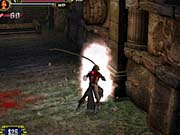
It's at least a little ironic that this new Castlevania is clearly inspired by Capcom's terrific 2001 game Devil May Cry, which was apparently inspired by the Castlevania series in the first place. Like Capcom's game, this one is 2D at heart despite the fully 3D visuals. The play mechanics are highly responsive, and the emphasis is on fast action rather than on camera manipulation or any cumbersome controls. In fact, like in Devil May Cry, you have no control over the camera at all; it shifts automatically as you proceed through the game's countless series of corridors and antechambers.
The camera angle is rarely a detriment, though there will undoubtedly be times when you'll be struck from offscreen; another minor issue is that the controls are always relative to the camera, so as the camera angle shifts, you'll need to compensate with the left analog stick to keep Leon moving straight ahead. Also, the combination of the constantly shifting camera angles (which tend to shift jarringly as you move from room to room) and the absence of a compass needle on the main game screen means you'll constantly be referring to your automap of the castle. The map is clear and easy to read and comes up quickly when you hit the select button. Still, you'll need to glance at it all the time as you try to plot a course from point A to point B, since it's so easy to become disoriented while traveling through the castle's same-looking hallways.
Structurally, the game is quite simple, and even more so than the recent GBA titles. Off to the side of the castle's foyer is a hub that leads you to the game's five main areas. These can be attempted and cleared in any order, and only after clearing all five can you then proceed to the last leg of your journey. The main areas superficially look different, but they are really quite similar. There are very few rooms that require you to consider the vertical orientation of the setting, whereas most Castlevania games involve either jumping over bottomless pits or at least a lot of jumping. By comparison, the jumping sequences here are quite rare, and the generally isometric camera angle can make lining up those jumps a little annoying. For what it's worth, there's no penalty for missing a jump other than falling to the ground below and having to climb back up and give it another try. From the get-go, Leon has the inexplicable ability to double-jump, and he can also use his whip to latch onto horizontal poles and propel himself forward. A few jumping sequences require you to time this whip-jump several times in a row, but you get to practice the technique very early on, and there's not much challenge to it despite its cool look.
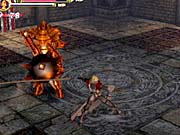
Though you do learn new whip techniques as you fight deeper into the castle, Lament of Innocence, unfortunately, has no role-playing elements, unlike its predecessors. You'll find some power-ups that increase your maximum health, magic power, and hearts (which are your "ammo" for your subweapons), but Leon doesn't gain experience points or experience levels just from beating up enemies. And, combat moves aside, he gains no special abilities over the course of the game. Unlike in recent Castlevania titles, you won't ever find yourself at an impasse here, wishing you had some special ability to let you advance, which later you'll acquire. Nor will you find a huge variety of weapons, armor, and/or accessories to equip, though Leon can, theoretically, equip different weapons, armor, and/or accessories. There just aren't many types to be found during the course of the game. Also, while Leon has the ability to use magic, this power is practically worthless. His magic meter drains quickly when these abilities are in use, and magic power isn't restored by conventional means (for instance, at save points). The abilities themselves are few and far between, and they are of limited use anyway. These types of issues make Lament of Innocence, literally, less of a game than the Symphonies or Arias of the Castlevania series, and they suggest that the game was finished in a hurry. Regardless, these missing features don't hurt the features that are implemented.
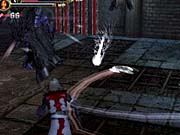
Leon, like a classic Castlevania protagonist, relies primarily on a whip to do his business, but he may also carry one of various useful subweapons. Every recent game in the series has included an interesting twist of some sort, which grants more depth to the gameplay as you get farther into the evil castle. In this case, Leon learns new whip combos and some other combat moves as he fights his way through droves of enemies, and after he beats the castle's main bosses, he also gets his hands on colored orbs, which enhance his subweapons with special properties. This system is actually very similar to that of last year's Castlevania: Harmony of Dissonance, a fine Game Boy Advance action game, by any means, though not quite as impressive as the Castlevania releases surrounding it; this is partly because the whip-and-subweapon combat system was pretty limited, much like it is here.
That's certainly not to say that the action is bad. Far from it. While most any Castlevania fan must have wondered at some point about how, exactly, a simple whip could damage the likes of the living dead, in Lament of Innocence, Leon's whip attacks appear extremely powerful. He lashes out with what looks like ferocious energy, laying into his foes with multihit combos that often send them careening backward, if not pulverizing them completely. Leon can block incoming strikes with his gauntlet, and he can execute fast and heavy attacks, linking these together in different combinations for various, effective results. Some attacks are better suited against groups of enemies while others strike straight ahead, and Leon can easily change direction in mid-combo if he's being surrounded. Later on in the game, he can lash his foes up into the air and smash them back down. Meanwhile, Leon's subweapons, consisting of mainstays like the holy water, knife, ax, and cross, give him a useful but limited ability to attack from range, and the effects of the orbs often make these special attacks better at damaging clusters of foes or temporarily enhancing Leon's defenses.
Leon's foes are mostly the walking dead, and they approach and attack with the sort of single-minded resolve you'd expect. Various types of skeletons will lunge with their swords and spears; disembodied suits of armor will thrust with axes and swing massive morning stars; and ghostly wolves, vampire bats, and flying stone gargoyles won't leave you alone. Some larger enemies, like ogres and cyclopes, will smash you backward with massive clubs. Almost every room offers a variety of such foes, and many rooms won't let you leave until you kill them all. Fortunately, once you've cleared out such a room once, you can just run on through the next time, even though your enemies will have respawned (the dead, of course, don't stay dead).
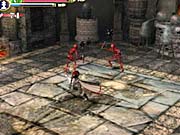
All these enemies are susceptible to your alchemic whip and subweapons, and you can carefully dance around their counterattacks by using your double-jump and the quick-dodge moves you learn soon into the adventure. Some of the normal enemies are tough, but, mostly, your enemies are dangerous only over time. You can carry some healing potions to regain your strength (interestingly, you can only use these by selecting them from a menu in real time, which can be a dangerous process), and you recover all your health at the game's fairly frequent save points. Sometimes, though, you'll find yourself worn down by your relentless adversaries, and you'll be ill-equipped to go on, let alone deal with one of the game's tough bosses.
The Castlevania series is famous for its challenging, inventive battles against its signature foes, and, in this regard, Lament of Innocence does not disappoint. Several of the bosses here will surely take you a good few tries before you learn their devious patterns and figure out how to (and then actually manage to) exploit their weaknesses. Overall, the game is challenging but not overly difficult. Save points are judiciously, but not too liberally, interspersed throughout the castle, as if to give the would-be damsel rescuer a tough-but-not-unfair time.
As mentioned, Lament of Innocence looks great, most notably because it runs at a silky smooth 60 frames per second at almost all times. Only during the game's overlong and rather unnecessary in-engine cutscenes does the frame rate slow down, and it may slow down in a few other instances, which you could count on one hand. Leon animates smoothly and looks impressive in action. His enemies look good too, and many of them are clear analogies to classic Casltevania foes. They often die in an over-the-top haze of blood, which seems to be the only explanation for the game's "M" rating. The bosses are suitably big and imposing, for good measure. The game's environments offer very little in the way of interaction, but they are, in turn, carefully and artistically textured to give them a spooky, distinctive appearance. The game's got plenty of the sort of gothic atmosphere you'd want out of a horror-themed game--or in a Castlevania in particular.
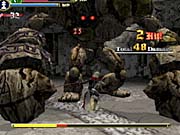
The gothic atmosphere is prevalent, thanks--in no small part--to the musical score of Lament of Innocence, which also, as mentioned, is terrific. Featuring that distinctive Castlevania blend of piano chords, bass riffs, strings, and choir, the soundtrack in this game is effective and memorable. The rest of the sound is great, too. A few classic Castlevania noises (like when you smash lanterns and pick up heart icons) combine with appropriately spirited grunts and battle cries from Leon and his foes to make this suitably seem like a next-generation Castlevania game. There's plenty of voice-over in the cutscenes of Lament of Innocence, and, for the most part, it's well done. The actors deliver their lines with conviction, though the script itself is awkward and drawn out, and the cutscenes just end up seeming incongruous with the rest of the game. Still, it's not the fault of the audio. As a bonus, Lament of Innocence preserves the original Japanese language track for those who'd rather hear bad scripts in foreign languages.
You should be able to finish Lament of Innocence somewhere in the vicinity of 10 hours or less, so it isn't that long. There are no multiplayer options, but the game does have a couple of substantial extra features, including an alternate playable character who's quite different from Leon and a "crazy" difficulty mode. Plus, the game itself has enough secrets to keep players involved and exploring every room of the castle. All this is nice, but the actual gameplay of Lament of Innocence is really what's best about it (or is it the soundtrack?). This just feels like Castlevania, meaning it's fast and good looking, rewards precision and timing, and puts you up against a slew of undead cohorts. Lament of Innocence does lack the sheer breadth built up in the GBA Castlevania titles, which have drawn on elements from one another over the years, so one can only hope that this will be another starting point for the series.